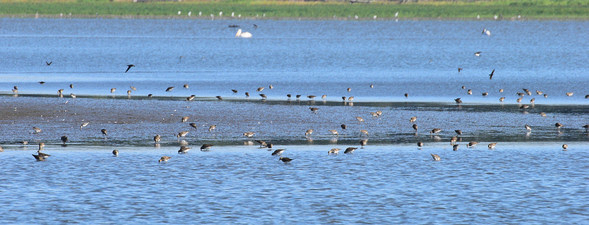
|
Lake Red Rock is in the midst of peak shorebird migration and currently hosting various sandpipers, sanderlings and lesser yellowlegs among the hundreds of pelicans and gulls. Photo courtesy of the Iowa DNR.
Birdwatchers know that heading north out of Pleasantville on North State Street, will lead them to a dead end at Lake Red Rock, near the impoundment that holds the greatest number of shorebirds available to birdwatchers without a boat.
The more adventurous will head out on foot from the gravel parking area to hike around the impoundment looking for shorebirds migrating from their breeding grounds in the tundra to the Gulf Coast of Texas and Mexico.
Lake Red Rock was commissioned by the U.S. Army Corps of Engineers for flood control, wildlife management and for recreation and while the wildlife management component on the lake itself revolved around water level manipulation that benefited migrating waterfowl, their management approach has shifted recently.
The Iowa Department of Natural Resources (DNR) and the U.S. Army Corps of Engineers have changed their management plan to lower the water level slightly to expose mudflats which is habitat needed for shorebirds.
Mudflats are home to invertebrates and exposing more mudflats creates opportunity for food necessary for shorebirds refueling on their thousands of miles journey to their wintering homes.
Todd Gosselink, wildlife biologist for the Iowa DNR, has been on the lake to see if the habitat manipulation is getting the intended response from the shorebirds.
Using a flat bottom boat outfitted with a mud-motor, Gosselink navigated through the shallow water of the Delta heading to the flats on this middle August morning. The Delta area is about a mile upstream from the Mile Long Bridge and while it looks like it holds a lot of depth, the water rarely gets deeper than a few feet.
At each exposed mudflat there were least sandpipers, semipalmated sandpipers, lesser yellowlegs, buff-breasted sandpiper and sanderlings. On this day, Gosselink found a semipalmated plover among the killdeer, but the most common species was the pectoral sandpiper. These shorebirds were mingling with hundreds of pelicans and gulls along with around 600 bluewing teal.
“We’re at the peak of the shorebird migration right now,” Gosselink said. “This is a deliberate attempt to manage for these shorebirds at Red Rock and Saylorville. Last week, we saw a juvenile piping plover here which was an extremely rare sighting in Marion County. A few weeks ago, there were four avocets.”
Piping plover is a federally endangered species due to loss of its nesting habitat on the beaches along the Great Lakes.
As the shorebird migration winds down, the waterfowl migration will pick up and Lake Red Rock is ready with tremendous waterfowl habitat that’s in really good shape, Gosselink said.
“When Red Rock isn’t flooding we have the great potential to manage for wildlife and conservation. Wild millet is excellent duck food and this year, it's thick,” he said.
The Corps will begin raising the water level in late September.
Media Contact: Todd Gosselink, Wildlife Biologist, Iowa Department of Natural Resources, 515-238-6936.